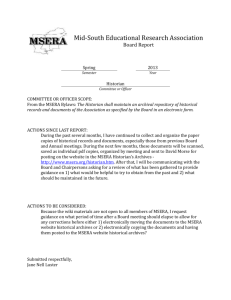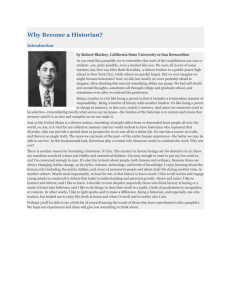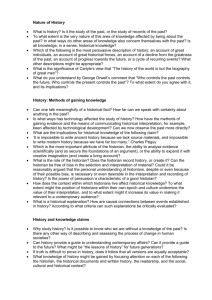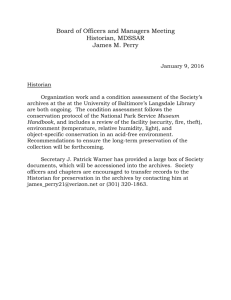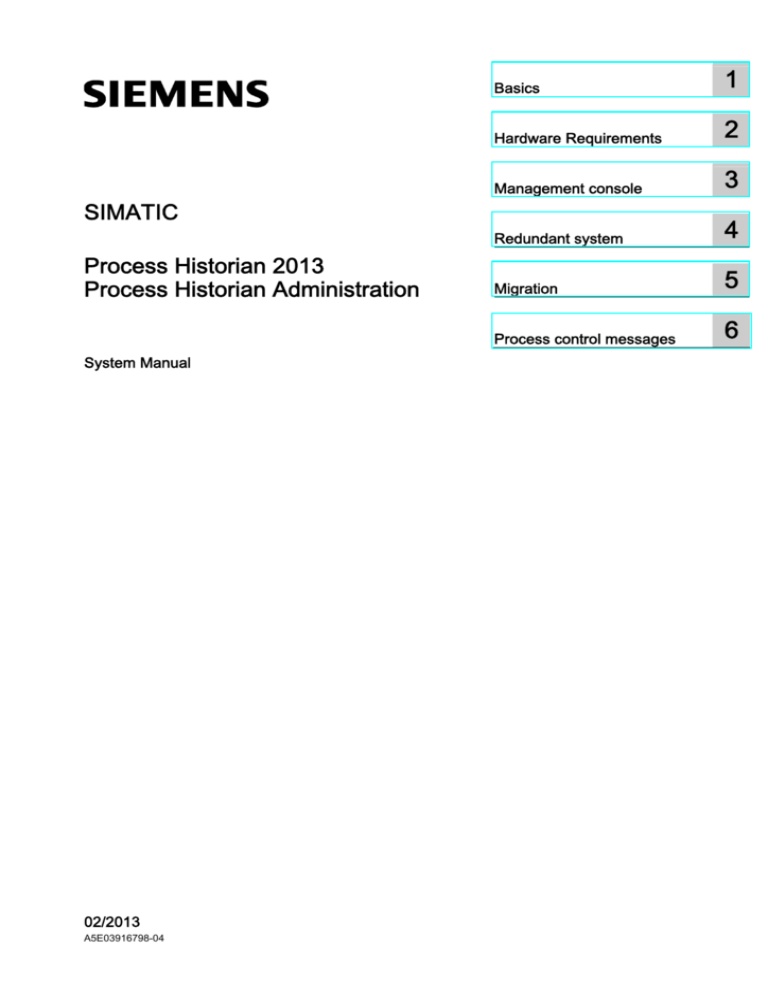
Process Historian Administration
1
___________________
Basics
2
___________________
Hardware Requirements
SIMATIC
Process Historian 2013
Process Historian Administration
3
___________________
Management console
4
___________________
Redundant system
5
___________________
Migration
___________________
6
Process control messages
System Manual
02/2013
A5E03916798-04
Legal information
Warning notice system
This manual contains notices you have to observe in order to ensure your personal safety, as well as to prevent
damage to property. The notices referring to your personal safety are highlighted in the manual by a safety alert
symbol, notices referring only to property damage have no safety alert symbol. These notices shown below are
graded according to the degree of danger.
DANGER
indicates that death or severe personal injury will result if proper precautions are not taken.
WARNING
indicates that death or severe personal injury may result if proper precautions are not taken.
CAUTION
indicates that minor personal injury can result if proper precautions are not taken.
NOTICE
indicates that property damage can result if proper precautions are not taken.
If more than one degree of danger is present, the warning notice representing the highest degree of danger will
be used. A notice warning of injury to persons with a safety alert symbol may also include a warning relating to
property damage.
Qualified Personnel
The product/system described in this documentation may be operated only by personnel qualified for the specific
task in accordance with the relevant documentation, in particular its warning notices and safety instructions.
Qualified personnel are those who, based on their training and experience, are capable of identifying risks and
avoiding potential hazards when working with these products/systems.
Proper use of Siemens products
Note the following:
WARNING
Siemens products may only be used for the applications described in the catalog and in the relevant technical
documentation. If products and components from other manufacturers are used, these must be recommended
or approved by Siemens. Proper transport, storage, installation, assembly, commissioning, operation and
maintenance are required to ensure that the products operate safely and without any problems. The permissible
ambient conditions must be complied with. The information in the relevant documentation must be observed.
Trademarks
All names identified by ® are registered trademarks of Siemens AG. The remaining trademarks in this publication
may be trademarks whose use by third parties for their own purposes could violate the rights of the owner.
Disclaimer of Liability
We have reviewed the contents of this publication to ensure consistency with the hardware and software
described. Since variance cannot be precluded entirely, we cannot guarantee full consistency. However, the
information in this publication is reviewed regularly and any necessary corrections are included in subsequent
editions.
Siemens AG
Industry Sector
Postfach 48 48
90026 NÜRNBERG
GERMANY
A5E03916798-04
Ⓟ 03/2013 Technical data subject to change
Copyright © Siemens AG 2013.
All rights reserved
Table of contents
1
Basics ........................................................................................................................................................ 5
1.1
Overview ........................................................................................................................................5
1.2
Data structures...............................................................................................................................7
1.3
Segmentation .................................................................................................................................9
2
Hardware Requirements.......................................................................................................................... 13
3
Management console .............................................................................................................................. 17
3.1
Overview ......................................................................................................................................17
3.2
Process Historian Management dashboard.................................................................................18
3.3
Plant Structure dashboard ...........................................................................................................20
3.4
I/O Systems dashboard ...............................................................................................................21
3.5
Diagnostics dashboard ................................................................................................................22
3.6
3.6.1
3.6.2
3.6.3
3.6.4
Backup/Restore dashboard .........................................................................................................23
Introduction ..................................................................................................................................23
Creating segment backups ..........................................................................................................24
Restoring a segment....................................................................................................................25
Deleting a segment ......................................................................................................................26
3.7
Compression dashboard..............................................................................................................27
3.8
Segmentation dashboard.............................................................................................................28
3.9
Dashboard Redundancy ..............................................................................................................30
3.10
Licensing dashboard....................................................................................................................32
4
Redundant system................................................................................................................................... 33
5
Migration.................................................................................................................................................. 37
6
Process control messages....................................................................................................................... 39
Index........................................................................................................................................................ 41
SIMATIC Process Historian Administration 2013 - Administration Guide
System Manual, 02/2013, A5E03916798-04
3
Table of contents
SIMATIC Process Historian Administration 2013 - Administration Guide
4
System Manual, 02/2013, A5E03916798-04
1
Basics
1.1
Overview
Introduction
SIMATIC Process Historian is a central archiving system for storing process data, such as
process values and messages. The Process Historian uses the
Microsoft SQL Server 2008 R2 SP1 64 Bit and archives historical data originating from a
PCS 7 Operator Station (OS)/ WinCC OS and SIMATIC BATCH. The data can belong to
different PCS 7 or WinCC projects. Access to the historical data is transparent for the OS
Clients.
Services
Process Historian employs four services for processing, storing and backing up data:
● SIMATIC Process Historian Server
This service implements all functions the server needs to process and store data.
● Process Historian Maintenance Service
This service implements all functions that are necessary to maintain the
Process Historian database. The Maintenance Service handles tasks such as starting
mirroring, mirror monitoring, restore functions, maintenance of the transaction log and
suchlike.
● Process Historian Redundancy Service
This service implements functions that are necessary for data exchange between two
redundant server systems.
● Process Historian Discovery Service
This service supports the search for connected Process Historian systems. The
Discovery Service is essential for the functionality of the Process Historian.
Operating states
You can give the Process Historian the following commands by using the shortcut menu of
the icon in the system tray:
● Starting
● Shutting down
● Starting restore
The following table provides an overview of the operating states and the color coding of the
associated icons in the system tray:
SIMATIC Process Historian Administration 2013 - Administration Guide
System Manual, 02/2013, A5E03916798-04
5
Basics
1.1 Overview
Symbol
Process Historian operating state
Description
Active
In the "Active" operating state, the Process Historian
archives data. You can query data from the OS Server or
Information Server.
Restoring
In the "Restoring" operating state, the Process Historian
requests data from an OS Server for a recognized period of
inactivity.
The preceding and the subsequent operating state is
"Active".
Starting restore
This operating state starts "Restoring".
Stopping restore
This operating state terminates "ActiveRecovery" and is an
intermediate state between "ActiveRecovery" and "Active".
Deactivated
The Process Historian changes to the "Deactivated"
operating state in the case of maintenance tasks where
access to the database is limited. The maintenance tasks
can include the creation or the backing up/restoring of
segments.
The system is offline in this operating state. Access via a
network is not possible.
Deactivate
"Deactivate" is the intermediate state between "Active" and
"Deactivated".
Error
The "Error" operating state occurs when an error has been
recognized or when no connection to the
SIMATIC Process Historian service exists.
Inactive
No data is archived in the "Inactive" operating state. In this
operating state, you can carry out updates, maintenance
work to the Process Historian PC or a restart of the PC.
Shutting down
Intermediate state between "Active" and "Inactive"
Starting
Intermediate state between "Inactive" and "Active"
Not defined
Initial state for "Inactive"
SIMATIC Process Historian Administration 2013 - Administration Guide
6
System Manual, 02/2013, A5E03916798-04
Basics
1.2 Data structures
1.2
Data structures
Value sequences
The Process Historian operates with time-variant value sequences that include runtime data
and configuration data (GUID). Each time-variant value sequence is identified by a sequence
identifier that references the configuration data and runtime data for a time-variant value
sequence.
The time-variant value sequences are divided into data groups in the Process Historian for
better parallel processing.
Each data group is assigned a storage location on a shared cluster of physical sources.
Such as a group of several hard disks, for example:
● Data group 1 on drive partition 1
● Data group 2 on drive partition 2
● etc.
Note
You can distribute the data groups among the available hard disks in order to influence the
performance and the scaling of the system used. Distribution is carried out using the Wizard
when creating the database.
Partition
The amount of runtime data of a single time-variant value sequence, such as an archive tag,
for example, is unlimited and grows constantly.
The entire amount of data that is assigned to an individual time-variant value sequence must
therefore be divided into several "partitions" using the time axis.
Data groups are divided into partitions using the time axis.
The following conditions apply to partitions:
● Each partition has a high and low limit for the time period.
● But the high time limit must always be higher than the low one.
● The partitions of a data group should not overlap.
Segment of a runtime database
A "segment" combines the data partitions of several data groups.
SIMATIC Process Historian Administration 2013 - Administration Guide
System Manual, 02/2013, A5E03916798-04
7
Basics
1.2 Data structures
A database segment consists of the sum of partitions of all data groups that share the same
high and low time limits. These groups correspond to the limits of the segment.
The difference between the high and low time limit is referred to as the "time period" of the
database segment.
Each segment has a unique segment number.
● The start segment, the first segment created in a system, has the number 100,000.
● The segment whose low limit is equal to the high limit of segment n is referred to as
segment n+1.
● The segment whose high limit is equal to the low limit of segment n is referred to as
segment n-1.
SIMATIC Process Historian Administration 2013 - Administration Guide
8
System Manual, 02/2013, A5E03916798-04
Basics
1.3 Segmentation
1.3
Segmentation
Introduction
The Process Historian can process and manage very large amounts of data. The saved data
is split up into segments so that performance is not impaired.
Segments are defined by a time period with a high and low time limit. A segment contains
the amount of data that was recorded during the defined time period.
By default, segments are created with a segment size of one week when the
Process Historian database is created. You can change this setting. You can find information
on changing segment configurations under 'Segmentation dashboard (Page 28)'.
You cannot retroactively reconfigure segments that already contain data.
Segmentation configuration
You can change the properties of segmentation on the "Segmentation" dashboard as
Process Historian administrator.
You can make the following settings:
● Anchor point of segmentation
● Time period of a segment
● Number of prepared segments
● Total number of runtime segments
The following table provides an overview of the basic segmentation parameters:
Parameter
Value
Description
Anchor point of
segmentation
Date, time
Start time of the segment
Time period
of the segment
Day, week, month, quarter, year
Segment size
Multiplier
Integer
Multiplier for the set time period for segmentation, the specified
segment size is multiplied by the selected number, the size of
the segment increases accordingly
Prepared segments
Total number of prepared segments
Total number of
runtime segments
Number of segments not yet archived and still in runtime
Number of segments
The Process Historian continuously creates segments with the defined time period. To
ensure that the entire period of possible times is covered, there is a high and a low "Catchall" segment. These special segments collect all incoming data that lies outside the current
runtime segment. These segments are called "Catch-all-upper" (CAU) and "Catch-all-lower"
(CAL). The CAL and CAU segments exist permanently. They cannot be deleted, removed or
set to offline.
SIMATIC Process Historian Administration 2013 - Administration Guide
System Manual, 02/2013, A5E03916798-04
9
Basics
1.3 Segmentation
Anchor point
When you change the anchor point, it should refer to a time at or after the last time stamp.
The anchor point of the segmentation does not have to be changed if the number of
prepared segments or the total number of runtime segments is to be changed. Any existing
segments are not deleted when the settings are changed (e.g. reducing the prepared
segments).
This means the new settings are not reached when you reduce the prepared signals until the
surplus and prepared segments have been exhausted.
If the number of prepared signals is increased, a segmentation with the new settings is
initiated immediately.
Note
If the last segment of the existing segmentation configuration ends before the anchor point of
the new segmentation, an intermediate segment must be created. This intermediate
segment starts with the end time of the last segment of the existing segmentation
configuration and ends with the start time of the new segmentation configuration. A suitable
anchor point is suggested to avoid the need for an intermediate segment. If you reject this
suggestion, an intermediate segment is created automatically.
Segments: Types
In the Process Historian, a distinction is made between segments of the "Runtime" and
"Archive" types.
Runtime segments are displayed on the "Segmentation" dashboard. They have the following
properties:
● The data in runtime segments can be changed by the Process Historian system at any
time.
● Runtime segments cannot be compressed.
● Runtime segments cannot be backed up.
Action
Change
Runtime segment
Archive segment
Yes
No
Compression
No
Yes
Back up
No
Yes
Delete
No
Yes
Archive segments are displayed on the "Backup/Restore" dashboard. These are
compressed or uncompressed, depending on the setting.
The status of a segment is classified as "Online" or "Offline".
● Segments of the "Runtime" type always have the status "Online".
● Segments of the "Archive" type can have the status "Online" or the status "Offline".
SIMATIC Process Historian Administration 2013 - Administration Guide
10
System Manual, 02/2013, A5E03916798-04
Basics
1.3 Segmentation
You can only read the contents of segments that are online. In order to read the contents of
segments that are offline, you have to restore these segments.
Note
Information about restoring a segment is available under 'Restoring a segment (Page 25)'.
Segments: Status
The properties of segments are structured as follows:
Type
Status
Reading
Writing
Archiving
Deleting
Runtime
Online
Yes
Yes
No
No
Archive
Online
Archive (archived)
Online
Archive (deleted)
Offline
Yes
Indirect
1)
Yes
No
Yes
Indirect 1)
Yes
Yes 2)
No
Indirect 1)
No
No
1)
Pending changes in the CAL segment are transferred to the archive segment during the backup.
2)
Can only be deleted if no changes to the data were carried out after the last archiving.
SIMATIC Process Historian Administration 2013 - Administration Guide
System Manual, 02/2013, A5E03916798-04
11
Basics
1.3 Segmentation
SIMATIC Process Historian Administration 2013 - Administration Guide
12
System Manual, 02/2013, A5E03916798-04
Hardware Requirements
2
The following section describes the hardware requirements for Process Historian.
Overview of the configuration
The hardware configuration shown here refers to the SIMATIC Process Historian and the
Information Server. The simple configuration of Process Historian provides a clear overview
of the topology.
The following figure illustrates a simple configuration:
A sufficiently powerful PC system is capable of handling all tasks involved. This configuration
is suitable for small-scale installations with corresponding quantity frameworks.
Hardware example for small quantity frameworks
For a data volume of up to three servers and a maximum archiving load of 1000 values per
second and server, you can use a SIMATIC IPC 847C.
This includes the following hardware:
SIMATIC Process Historian Administration 2013 - Administration Guide
System Manual, 02/2013, A5E03916798-04
13
Hardware Requirements
CPU
Core i7-610E (2C/ 4T, 2,53 GHz, 4 MByte Cache, TB, VT-x,
VT-d, EM64-T)
Work memory (RAM)
8 GByte DDR3 SDRAM (2 x 4 GByte), DIMM, ECC,
Dual Channel
Hard disks
1 x 100 GByte SSD SATA; internal
Operating system and software
RAID 5 (3 x 1 TByte, HDD SAS) in removable drive bay,
Hot Swap, on the front.
PH Database and transaction log
RAID controller
HW-RAID Controller PCIe X8 in PCIe X16 Slots incl. Batterie
Backup Unit (BBU)
The specified RAID 5 system has a capacity of approximately 1.8 TByte.
All SAS HDDs are connected to the hardware RAID controller.
Process Historian and Information Server on the same system
Process Historian and Information Server can be installed and operated on the same
system.
In this case the two server applications share the available hardware resources. It is
advisable to install higher-grade equipment in order to be prepared for higher data request
rates from the WinCC client systems and Information Server clients. We recommend
16 GByte in this case.
Hardware example for medium quantity frameworks
For a data volume of up to 12 servers and an archiving load of up to 12,000 values per
second, you use a system with hardware comparable to the following example.
The configuration of a PRIMERGY TX300 S6 with minimum equipment as follows:
CPU
Intel Xeon X5690 6C/ 12T 3.46 GHz 12 MB
Work memory (RAM)
4 x 8 GB DDR3 1333 MHz PC3-10600
Hard disks
RAID 1; 2 x HD SAS 6G 300 GB 10K HOT PL 2.5"
RAID controller
Operating system and software
RAID 1; 2 x HD SAS 6G 300 GB 10K HOT PL 2.5"
Transaction log
RAID 10; 4 x HD SAS 6G 900 GB 10K HOT PLUG 2.5"
PH database
SAS 6G 5/ 6 512 MB (D2616); BBU expansion RAID 5/ 6 V16
The RAM and the number of processors and hard disks can be expanded with this
configuration.
The hardware configuration described is based on the use of internal hard disks for:
● Operating system, SQL server software,
● Process Historian Database
● And transaction log.
You can expand the scale in regard to database size and performance by using a
Storage Area Network (SAN).
SIMATIC Process Historian Administration 2013 - Administration Guide
14
System Manual, 02/2013, A5E03916798-04
Hardware Requirements
The creation and distribution of the database over several symmetric database groups on
physically separate RAID systems also allows for a scaling of performance.
Hardware example for large quantity frameworks
For a data volume from several projects and an archiving load of more than 12,000 values
per second, you use a system with hardware comparable to the following example.
The configuration of a PRIMERGY RX300 S7 with minimum equipment as follows:
CPU
2 x XEON E5-2690 16C/ 32T 2,9 GHz
Work memory (RAM)
49152 MB
Hard disks (internal)
4 x 300 GB 2 x RAID 1
Operating system and software
Storage Area Network
4 x RAID 1 (je 2 x HD SATA 2 TByte)
PH Database: 4 tag data groups
from 0 to 3
6 TByte (3 x RAID 1, je 2 x HD SATA 2 TByte)
PH Database: Alarms, BATCH
data, configuration data tags and
alarms
3 TByte (3 x RAID 1, je 2 x HD SATA 1 TByte)
PH Database: Transaction log,
general data groups
RAID controller
SAN Infortrend DS S24F-G2840-4 (14 x 2 TB, 6 x 1TB)
Redundant Process Historian servers
A redundant Process Historian system consists of symmetrically configured servers for
Master (Principal) and Standby (Mirror) operation (e.g. PRIMERGY TX300 S6).
We recommend a dedicated redundancy connection with a minimum bandwidth of 1 Gbit
between the redundant Process Historian servers.
The Witness server component for scenarios with automatic redundancy failover is also
installed on an additional server of the plant, depending on availability of an Information
Server or WinCC server.
SIMATIC Process Historian Administration 2013 - Administration Guide
System Manual, 02/2013, A5E03916798-04
15
Hardware Requirements
SIMATIC Process Historian Administration 2013 - Administration Guide
16
System Manual, 02/2013, A5E03916798-04
3
Management console
3.1
Overview
The management console is included in the installation of the Process Historian. It is used
for diagnostics and configuration of the Process Historian system and is automatically
started upon logon. For a manual start, open the management console by using "Start >
Programs > Siemens Automation > SIMATIC > Process Historian >
Process Historian Management Console".
The following table shows the dashboards of the management console and their tasks:
Dashboard
Description
Process Historian Management
System structure
I/O systems
Diagnostics
Backup/Restore
Compression
Segmentation
Display of fundamental hardware indicators and performance
indicators for the PC and operating system
Display of basic indicators for the status and current activity of
the Process Historian server
Display of the license status
Redundancy status
Changing the operating state
Display of incorporated projects
Display of the OS server systems
Display of the PC name
Display of the available input and output devices
Display of the memory space used
Detailed information about the load
Diagnostic messages of the Process Historian
Messages from the event display of the operating system
Display of the segments of the "Runtime" type
Display of the segments of the "Archive" type
Creating segment backups
Restoring backed-up segments
Display of the compression state
Turning on and turning off the post-compression
Configuration of the number of uncompressed archive segments
Display of the current segmentation setting
Changing the segmentation settings
SIMATIC Process Historian Administration 2013 - Administration Guide
System Manual, 02/2013, A5E03916798-04
17
Management console
3.2 Process Historian Management dashboard
Dashboard
Description
Redundancy
Display of the redundancy status
Switchover/ disconnection of principal (master) and mirror
(standby)
Redundancy configuration
Display of the current license status of server and project
Licensing
Note
Process Historian does not archive data
If the Process Historian does not archive data, check the Microsoft Message Queueing
(MSMQ) and the databases.
3.2
Process Historian Management dashboard
The "Process Historian Management" dashboard includes information about:
● Basic indicators for monitoring the PC:
– Processor load (CPU)
– Free memory (RAM)
– Hard disk load (data medium load)
● Basic indicators on Process Historian:
– Number of connected data sources
– Stored tags per second
– Stored messages per second
● Operating state of the Process Historian server
● Redundancy status of the Process Historian
● Licensing status of the Process Historian
SIMATIC Process Historian Administration 2013 - Administration Guide
18
System Manual, 02/2013, A5E03916798-04
Management console
3.2 Process Historian Management dashboard
Status control
Process Historian status: Changing the operating mode
The operating state of the Process Historian can be changed on the
"Process Historian Management" dashboard.
You can choose from the following operating modes:
● Start
● Shutting down
● Starting restore
For this purpose, select the respective entry from the drop-down list in the "Process Historian
status" area.
Redundancy and licensing status
The status respectively displayed can be updated in the redundancy and licensing status
fields.
SIMATIC Process Historian Administration 2013 - Administration Guide
System Manual, 02/2013, A5E03916798-04
19
Management console
3.3 Plant Structure dashboard
3.3
Plant Structure dashboard
The "Plant Structure" dashboard displays all projects that are currently integrated in the
system.
When you select a project the following information on the project is displayed:
● Name
● Type
● Description
SIMATIC Process Historian Administration 2013 - Administration Guide
20
System Manual, 02/2013, A5E03916798-04
Management console
3.4 I/O Systems dashboard
3.4
I/O Systems dashboard
The "I/O Systems" dashboard displays the entire memory system to which there is read and
write access and in which data is archived. The dashboard displays all hard drives integrated
in the system. This includes hard drives that do not contain archive data.
The "I/O systems" dashboard displays the following information on the storage system:
● Name and drive letter of the hard drives
● File system
● Total storage space: Capacity
● Absolute available storage space
● Free storage space in percent
● Absolute storage space used
The states of the input and output devices are graphically monitored by the system. If you
select a drive, you receive the following detailed information on the selected drive:
● Idle time of the hard drive: Idle time
● Average duration per transfer
● Average length of queue for read access
● Byte per second with read access to data medium
● Average length of queue for write access
● Reading speed in Byte per second
● Writing speed in Byte per second
SIMATIC Process Historian Administration 2013 - Administration Guide
System Manual, 02/2013, A5E03916798-04
21
Management console
3.5 Diagnostics dashboard
3.5
Diagnostics dashboard
The upper area of the "Diagnostics" dashboard displays the last 1000 diagnostic messages
from the Process Historian event log.
The event log of the Process Historian contains the following information:
● Log entry ID
● Severity of the message
● Time stamp
● Name of application domain
● Process ID
● Message
The lower section of the dashboard includes the last 100 entries from the event log for
Windows applications. The following information is displayed:
● Time stamp
● Message
● Category
● Source
SIMATIC Process Historian Administration 2013 - Administration Guide
22
System Manual, 02/2013, A5E03916798-04
Management console
3.6 Backup/Restore dashboard
3.6
Backup/Restore dashboard
3.6.1
Introduction
Backup types
The Process Historian saves process values and messages in temporally defined segments.
Back up the contents of the Process Historian database correspondingly by segment.
When an archive segment is backed up, the runtime data is stored in the backup file. The
stored data includes:
● Process values
● Messages
● Configuration data
You can plan the backup of data using the "Settings ..." button in the "Archive segments"
area of the 'Backup/Restore' dashboard.
You can make selected archive segments available as runtime data once again by using the
"Restore ..." button in the 'Restore segments' area.
SIMATIC Process Historian Administration 2013 - Administration Guide
System Manual, 02/2013, A5E03916798-04
23
Management console
3.6 Backup/Restore dashboard
3.6.2
Creating segment backups
Requirement
● The segment to be backed up has the "Archive" status.
Note
During backup or restore, the Process Historian briefly switches to the "Deactivated" state up
to two times.
Your access to the database is limited in this operating state.
Procedure
Manual backup
1. Select the "Backup/Restore" dashboard in the navigation of the management console.
2. Select the segment you want to back up in the "Archive segments" area.
SIMATIC Process Historian Administration 2013 - Administration Guide
24
System Manual, 02/2013, A5E03916798-04
Management console
3.6 Backup/Restore dashboard
3. Click the "Backup" button to launch backup.
4. Select the storage location for the backup file in the "Backup segment" dialog box that
opens. Click "Backup".
You can specify further identifiers and descriptions for the backup such as the name or
number of the data medium.
Automated backup
You can plan the backup of data and automate backup processes using the "Settings ..."
button in the 'Archive segments' area of the 'Backup/Restore' dashboard.
Result
A backup is created and the date of the backup entered. The segment remains in the
"Online" status and is not moved.
3.6.3
Restoring a segment
If you want to access data that is stored in an archived segment, you must restore the
respective segments. When restoring a segment, you must select the backup file
corresponding to the segment.
Note
During backup or restore, the Process Historian briefly switches to the "Deactivated" state up
to two times.
Your access to the database is limited in this operating state.
Requirement
● The corresponding backup file for the segment to be restored is available.
● The Process Historian is in the "Active" operating state.
Procedure
1. Select the "Backup/Restore" dashboard in the navigation of the management console.
2. Select the required segment in the "Restore segments" area.
3. Click on the "Restore" button.
4. In the "Backup segment" dialog, select the corresponding backup file for the segment that
is to be restored.
5. Click "Restore".
SIMATIC Process Historian Administration 2013 - Administration Guide
System Manual, 02/2013, A5E03916798-04
25
Management console
3.6 Backup/Restore dashboard
Result
You can access the data of the restored segment from the OS Server, OS Client or the
Information Server.
3.6.4
Deleting a segment
There are two types of segments in Process Historian, runtime segments and archive
segments. Runtime segments are always online and cannot be deleted.
As soon as the runtime segment becomes an archive segment, you can perform a backup
for it. The archive segment can be deleted (set offline) after successful backup.
The system only saves the information to restore the backed up segment.
Requirement
● There is a valid backup for the segment that is to be deleted.
Note
You can only use the "Set offline" button if a backup of the selected segment has already
been created and this segment is marked as "valid". A segment is, for example, marked as
"invalid" if additional runtime data for the segment has accumulated after the creation of a
backup. In this case, create a backup of the relevant segment again.
You can only delete segments individually.
Procedure
1. Select the "Backup/Restore" dashboard in the navigation of the management console.
2. Select the segment you want to delete in the "Archive segments" area.
3. Click the "Set offline" button.
Result
The segment is deleted from the database.
SIMATIC Process Historian Administration 2013 - Administration Guide
26
System Manual, 02/2013, A5E03916798-04
Management console
3.7 Compression dashboard
3.7
Compression dashboard
On the "Compression" dashboard, you can see the current compression state as well as the
current default number of uncompressed segments contained. The contained uncompressed
segments are counted starting from the first archive segment.
Note
The archive segments are compressed automatically in the background. You can set the
number of archive segments that are not to be compressed. The possible compression
factor depends on additional influences, such as the number and archiving cycles of the
process values.
Procedure
1. Select the "Compression" dashboard in the navigation of the management console.
2. Select the "Activate" option in the 'Configuration' area for 'Post compression'.
3. Specify the number of uncompressed segments you want to keep in the "Configuration"
area.
4. Click "Apply".
Result
The settings for the compression of archive segments have been reconfigured.
SIMATIC Process Historian Administration 2013 - Administration Guide
System Manual, 02/2013, A5E03916798-04
27
Management console
3.8 Segmentation dashboard
3.8
Segmentation dashboard
The "Segmentation" dashboard provides an overview of the current segmentation
configuration.
You configure the segmentation of the Process Historian archives in the "Settings" area.
The segment states are color coded:
Segment status
Color
Completed runtime segment
Gray
Current segment
Green
Prepared segment
Blue
You specify the following parameters for configuration of the segmentation in the "Settings"
area:
1. Segmentation anchor point:
– Hour
– Date
2. Time period for segments:
– Unit (period)
– Factor
3. Number of segments:
– Number of future segments
– Total number of runtime segments
SIMATIC Process Historian Administration 2013 - Administration Guide
28
System Manual, 02/2013, A5E03916798-04
Management console
3.8 Segmentation dashboard
The "Database Installation Wizard" supports you in the installation of the Process Historian
database. By default, the following presettings are made for the segmentation during
installation:
Segment size
One week
Total number of segments in runtime
Eight
Number of prepared segments
Three
Note
Process Historian Installation Notes
Additional information on defaults of the Process Historian database is available in the
Installation Notes.
Depending on the quantity structure, the amount of data per segment can be very large. This
applies to all segments in runtime. When the segments are created, the estimated required
memory space is reserved.
The optimum settings for the segmentation are a compromise between the memory space
used and the number of uncompressed data segments to be reserved.
Note
The Process Historian database is switched automatically to the "Deactivated" state to allow
changes to the segmentation to be carried out. After the settings have been accepted, the
database changes back to the "Active" state automatically.
Procedure
1. Select the "Segmentation" dashboard in the navigation of the management console.
2. In the "Number of segments" area, select the required number of segments to be
prepared continuously.
3. In the "Number of segments" area, select the required total number of runtime segments.
4. Click "Apply".
Result
The segmentation of the Process Historian database is configured.
SIMATIC Process Historian Administration 2013 - Administration Guide
System Manual, 02/2013, A5E03916798-04
29
Management console
3.9 Dashboard Redundancy
3.9
Dashboard Redundancy
You configure the redundancy of the Process Historian in the 'Redundancy' dashboard.
You specify the configuration for a redundant system in the following areas:
● Redundancy status
● Remove redundancy
● Redundancy
To create a new redundant system, click the "Start redundancy configuration..." button in the
'Redundancy' area.
Follow the instructions of the "Process Historian Redundancy Wizard" to configure a new
redundant system.
Note
Process Historian Redundancy Wizard
You will find detailed information on redundancy configuration in the Process Historian
Installation Notes.
SIMATIC Process Historian Administration 2013 - Administration Guide
30
System Manual, 02/2013, A5E03916798-04
Management console
3.9 Dashboard Redundancy
Redundant Process Historian servers
A redundant Process Historian system consists of symmetrically configured servers for
master (principal) and standby (mirror) operation (e.g. PRIMERGY TX300 S6). We
recommend a dedicated redundancy connection with a minimum bandwidth of 1 Gbit
between the redundant Process Historian servers. The Witness server component for
scenarios with automatic redundancy failover is also installed on an additional server of the
system, depending on availability of an Information Server or WinCC server.
Note
Redundancy
More information on redundant systems can be found in the section 'Redundant system
(Page 33)'.
SIMATIC Process Historian Administration 2013 - Administration Guide
System Manual, 02/2013, A5E03916798-04
31
Management console
3.10 Licensing dashboard
3.10
Licensing dashboard
Dashboard
The "Licensing" dashboard gives you an overview of the licenses used and available in the
system.
The availability of the Process Historian license is displayed.
You also obtain detailed information about the states of the tag licenses:
● Available
● Required
● Free
The Process Historian does not require any archive tag licenses for the PCS 7 OS/ WinCC
sources.
When you select a project, you receive information on the project-specific license status with
the following information:
● Project name
● Project type
● Number of tags
SIMATIC Process Historian Administration 2013 - Administration Guide
32
System Manual, 02/2013, A5E03916798-04
Redundant system
4
Redundancy
The redundant systems are based on the Microsoft SQL Server mirroring.
Process Historian requires a third system to monitor the availability of redundancy. The
Information Server can usually be assigned the role of 'Witness'.
Note
Setting up redundancy
You start the Redundancy Wizard using the "Redundancy" dashboard of the
Process Historian management console. You can find additional information in the section
'Dashboard redundancy (Page 30)' as well as in the Process Historian Installation Notes.
Scenarios for standard behavior
The following terms are used without product labels in this section for better readability:
● Principal: Process Historian Master
● Mirror: Process Historian Standby
● Witness: Information Server
Overview of redundancy scenarios
SIMATIC Process Historian Administration 2013 - Administration Guide
System Manual, 02/2013, A5E03916798-04
33
Redundant system
1. The Mirror is temporarily inactive:
– The Principal and the Mirror are active and synchronized.
– The Mirror is separated from the network, for example, for maintenance work.
– There is no data synchronization between the Principal and the Mirror in this case.
– The transaction log on the Principal is growing.
– The Mirror is reactivated after a certain period.
– The Principal and Mirror are in the resynchronization status.
– Once the data is synchronized, the two server systems are once again synchronized
and redundant.
2. The Principal fails:
– The Principal and the Mirror are active and synchronized.
– The Principal server system fails.
– The Mirror queries the Witness, if it has an active connection to the Principal.
– If the Witness does not have a connection to the Principal, the Mirror automatically
switches to 'Principal' mode.
– If the Witness has an active connection to the Principal, there is no automatic failover.
– Before the Mirror switches to Principal mode, the pending data from the transaction
log is processed.
This may take some time.
– The connection to the Principal is re-established.
– The previous Principal now takes on the role of the 'Mirror'.
– The Principal and the Mirror are in the resynchronization status.
– Once the data is synchronized, the two server systems are once again synchronized
and redundant.
3. The Witness fails:
– The Principal and the Mirror are active and synchronized.
– The Witness server fails.
– A failover is not necessary, because none of the archiving systems is affected.
– An automatic failover is not possible in this case.
– The Witness is active once again.
– Automatic failover is possible once again.
SIMATIC Process Historian Administration 2013 - Administration Guide
34
System Manual, 02/2013, A5E03916798-04
Redundant system
4. The Mirror is disabled and will not be available for a longer period of time.
– The Principal and the Mirror are active and synchronized.
– The Mirror is separated from the network, for example, for maintenance work.
– Data synchronization between the Principal and the Mirror does not take place.
– The transaction log on the Principal is growing.
– Redundancy synchronization (Mirroring) must be deactivated to prevent an overflow of
the transaction log.
– If it is not deactivated in time, Mirroring ends automatically as soon as the transaction
log becomes too large for the hard disk capacity.
This automatic function ensures the availability of the Principal.
– The Mirror is active once again.
– Data is not synchronized; Mirroring must be set up once again.
5. The Mirror and the Principal are switched off and on in succession:
– Both servers, Principal and Mirror, are synchronized.
– The data is redundant and identical on both servers.
– The Mirror is switched off.
– The data is still saved on the Principal.
The data is no longer synchronized because the Mirror is switched off.
This means the database on both servers is not identical.
The transaction log of the Principal is growing.
– The Principal is switched off.
– No data can be saved.
– The previous Mirror is switched on.
– The Mirror works but data cannot be synchronized with the Principal.
To prevent the risk of data loss, there is no automatic failover from Mirror for the
Principal in this case.
If a manual failover is forced, the previous Mirror would take over the role of the
switched off Principal.
If the actual Principal is switched on once again, it takes over the role of 'Mirror'.
The previously saved data would be deleted in case of a synchronization with the new
'Principal' that is actually missing these databases.
These technical conflicts can be resolved in different ways with the Process Historian
management console. The options for resolving these conflicts are described in the following
section.
SIMATIC Process Historian Administration 2013 - Administration Guide
System Manual, 02/2013, A5E03916798-04
35
Redundant system
Conflict management with the Process Historian management console
1. Failover (switchover)
– In case of a failover, the Principal and the Mirror swap roles.
– This is only possible when the systems are synchronized.
2. Disconnect(Separate)
– In case of a disconnect, the current Mirror is declared as 'Principal' even if the systems
are not synchronized at this time.
– This results in a loss of data that is not synchronized.
– This procedure is only available on the Mirror.
– You should only use this function if the Principal is in an undefined state or if the
automatic failover fails.
3. Remove (Delete)
– Mirroring ends when the redundancy is removed.
– This procedure is only available on the Principal.
– You should only use this function if the Mirror does not respond or is not/will not be
available for a long time.
– This action terminates the growth of the transaction log.
SIMATIC Process Historian Administration 2013 - Administration Guide
36
System Manual, 02/2013, A5E03916798-04
5
Migration
Migration of CAS databases to the Process Historian
The following graphic shows the concept of migrating a CAS (Central Archive Server)
database to the Process Historian in an PCS 7/ WinCC environment.
Legend
1. Setting up of a new computer with the Process Historian including the database migration
tool.
2. Updating of the software of the Engineering Station.
3. Migrating the PCS 7 project.
4. Within the PCS 7 project:
– Manual deleting of the PC station CAS (Central Archive Server).
– Setting up a new PC station for the Process Historian.
SIMATIC Process Historian Administration 2013 - Administration Guide
System Manual, 02/2013, A5E03916798-04
37
Migration
5. Stopping of the servers/ individual stations and updating of the software.
6. Updating of the OS projects and restarting of the OS-Server/ individual stations.
7. The OS-PH communication is established automatically.
The active OS-PH communication is mandatory, because the CAS databases cannot be
assigned to a project otherwise.
8. Starting of the Migration Tool, selection of the CAS database server and starting of the
migration process.
Migration of all the CAS databases is carried out in the background during running operation.
Note
Configuration of the service CCCAPHService
The service for the Process Historian Ready must be configured before you restart the
updated OS-Server/ individual stations.
Additional information is available in the Process Historian Installation Notes, in the section
'Install Process Historian Ready component'.
Replacing a CAS object in a PCS 7 project by a PH object
The following steps have to be carried out for a PH Migration to an ES (Engineering
System).
1. Remove the PC station with the 'CAS' role from the PCS 7 project.
2. Open the OS allocation dialog and and clear the CAS allocation at all OS Clients and OSServer.
If the CAS object is deleted on the ES, the paging paths for the archive backup files of the
OS are not deleted automatically. They have to be deleted manually by the user.
If the CAS computer does no longer exist and the paging paths are still listed, a process
control message is output each time there is a segment change.
3. Setting up a new PC station for the Process Historian
Note
Delete CAS paging paths/ deactivating backup
The CAS paging paths must be deleted in the properties of the tag logging and alarm logging
archives. The backup must also be deactivated.
SIMATIC Process Historian Administration 2013 - Administration Guide
38
System Manual, 02/2013, A5E03916798-04
Process control messages
6
Overview
Process Historian contains process control messages that visualize specific system states.
These pre-defined messages only contain information about process control states and do
not return process status data.
The following table provides an overview of the process control messages generated in
Process Historian:
Message number
Message text
1012500
PHRDY: Start recovery for Process Historian
1012501
PHRDY: Recovery for Process Historian complete
1012502
PHRDY: No communication with Process Historian possible
1012503
PHRDY: Communication with Process Historian is interrupted
1012504
PHRDY: Communication with Process Historian is restored
1012505
PHRDY: Process Historian server offline since @1%s@
1012506
PHRDY: Buffer limit channel @1%s@ exceeded
1012507
PHRDY: Buffer limit channel @1%s@ normal
1012600
PH: Data capacity @1%d@% full
1012601
PH: System out of resources
1012602
PH: Redundancy failed
1012603
PH: Redundancy restored
1012604
PH: Available licenses exceeded. Shutdown in @1%d@ days
1012605
PH: PH-Ready @1%s@ failed
SIMATIC Process Historian Administration 2013 - Administration Guide
System Manual, 02/2013, A5E03916798-04
39
Process control messages
SIMATIC Process Historian Administration 2013 - Administration Guide
40
System Manual, 02/2013, A5E03916798-04
Index
C
Changing the operating mode, 19
D
Diagnostic message, 22
E
Event log, 22
S
Segmentation
Anchor point, 10
SIMATIC Process Historian Administration 2013 - Administration Guide
System Manual, 02/2013, A5E03916798-04
41
Index
SIMATIC Process Historian Administration 2013 - Administration Guide
42
System Manual, 02/2013, A5E03916798-04



